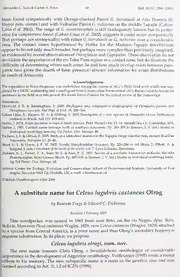
A substitute name for Celeus lugubris castaneus Olrog PDF
Preview A substitute name for Celeus lugubris castaneus Olrog
AlexanderC. Lees&CarlosA. Peres 69 Bull. B.O.C.2008 128(1) been found sympatrically with Orange-cheeked Parrot G. barrabandi at Alta Floresta (R. Hoyer pers. comm.) and with Vulturine Parrot G. vulturina on the middle Tapajos (Gaban- Lima et al. 2002). The range of G. aurantiocephala is still inadequately known but its prefer- ence for campinarana forest (Gaban-Lima et al 2002) suggests it could occur sympatrically (but perhaps not syntopically) with either G. barrabandi or G. vulturina over a considerable area. The contact zones hypothesised by Haffer for the Madeira-Tapajos interfluvium appear to be not onlymuchbroader, butperhaps more complex thanpreviously imagined, as evidencedbyrecent observations ofPteroglossus and Gypopsitta. These discoveries donot invalidate the importance oftherioTeles Pires regionas acontactzone,butdo illustratethe difficulty ofdetermining where such zones lie and how much overlap existsbetweenpara- patric taxa given the dearth of basic presence/absence information for avian distributions in much of Amazonia. Acknowledgements The expeditiontoNovo Progressowas undertakenduringthe course ofACL'sPh.D. fieldworkwhichwas sup- portedbyaNERCstudentshipandasmallgrantfromConservationInternational.ACLthanksGeraldoAraujofor assistanceinthefieldoverthisperiod.WethankKevinZimmerforhiscriticalreviewofthemanuscript. References: Eberhard, R. & Bermingham, E. 2005. Phylogeny and comparative biogeography of Pionopsitta parrots and J. Pteroglossustoucans.MolPhyl. &Evol. 36: 288-304. Gaban-Lima, R., Raposo, M. A. & Hofling, E. 2002 Description ofanew species ofPionopsitta (Aves: Psittacidae) endemictoBrazil.Auk119: 815-819. Haffer,J. 1974.Avianspeciationin tropicalSouthAmerica.Publ.NuttallOrn.CI. 14.NuttallOrn.CL,Cambridge,MA. Haffer,J. 1997. Contact zonesbetweenbirds of southern Amazonia. Pp. 281-305 in Remsen, J. V. (ed.) Studies in NeotropicalornithologyhonoringTedParker. Orn. Monogr. 48. Pacheco,J. F. &Olmos,F. 2005. BirdsofalatitudinaltransectintheTapajos-Xinguinterfluvium,easternBrazilian Amazonia.Ararajuba 13:29-46. Short, L. L. & Home, J. F. M. 2002. Family Ramphastidae (toucans). Pp. 220-266 in del Hoyo, J., Elliott, A. & Sargatal,J. (eds.)Handbookofthebirdsoftheworld,vol. 7. LynxEdicions,Barcelona. Zimmer, K. J., Parker, T. A., Isler, M. L. & Isler, P. R. 1997. Survey of a southern Amazonian avifauna: the Alta Florestaregion,MatoGrosso,Brazil.Pp. 887-918inRemsen,J.V. (ed.) StudiesinNeotropicalornithologyhonor- ingTedParker. Orn.Monogr.48. Address: Centre for Ecology, Evolution and Conservation, School of Environmental Sciences, University of East Anglia,NorwichNR472J,Norfolk,UK,e-mail: [email protected] ©BritishOrnithologists'Club2008 A substitute name for Celeus lugubris castaneus Olrog by Rosendo Fraga & Edward C. Dickinson Received1 February2007 This woodpecker was named in 1963 from near Bato, on the no Negro, dpto. Beni, BoHvia. HoweverPicus castaneus Wagler, 1829, now Celeus castaneus (Wagler, 1829) attached to a species from Central America, is a prior name and thus Olrog's secondary homonym requires substitution. In its place, we propose: Celeus lugubris olrogi, nom. nov. The new name honours Claes Olrog, a Swedish-born ornithologist of considerable importance inthe developmentofArgentine ornithology. Vuilleumier (1995) wrote a recent tribute to his memory. The new subspecific name is a noun in the genitive case and was formed according to Art. 31.1.2 of ICZN (1999). RosendoFraga&EdwardC. Dickinson 70 Bull. B.O.C.2008128(1) The type (no. 11902) in the Institute Miguel Lillo, Tucuman, has been examined and photographed. Itis amaleand atfirstglanceappears sufficientlydifferenttowarrantrecog- nition. Olrog described it as distinct in colour, being chocolate-brown rather than the brownishblack ofthenominate orblackishlike C. /. kerriHargitt, 1891. AlthoughOlroghad two specimens that he attributed to the more easterly C. /. rooseveiti Cherrie, 1916, he men- , tioned no differencebetweentheseandhisnewform, exceptto statethatthe sizeofthenew race differed from all others. Olrog had six Bolivian specimens that he attributed to this ' form,three eachfrom Beni and Santa Cruz de la Sierra. Further studyis required to confirm ! the distinctness of this population. Acknowledgements The discovery ofthis homonymyaroseduringworkonDickinson (2003) andwethankNorbertBahrforsharing i names proposed since Peters' Check-list. We are also grateful to A. Echevarria at the Instituto Miguel Lillo in Tucumanforaccesstospecimens. ) References: Dickinson, E. C. (ed.) 2003. TheHoward &Moore complete checklist ofthe birds ofthe world. Third edn. Christopher Helm,London. International Commission on Zoological Nomenclature (ICZN). 1999. International code ofzoological nomenclature. Fourthedn.TheInternationalTrustforZoologicalNomenclature,c/oTheNaturalHistoryMuseum,London. Olrog,C. C. 1963.UnanuevasubespeciedeCeleuslugubrisdeBolivia (Aves,Piciformes,Picidae).Neotropica9(29): 87-88. Vuilleumier,F. 1995. FivegreatNeotropicalornithologists:anappreciationofEugeneEisenmann,MariaKoepcke, ClaesOlrog,RodulfoPhilippi,andHelmutSick. Orn. Neotrop. 6:97-111. Addresses: Rosendo M. Fraga, Centro de Investigaciones Cientfficas de Entre Rfos (CICYTTP), Conicet, Espana y ' Matteri, (3105) Diamante, Entre Rios, Argentina, e-mail: [email protected]. Edward C. Dickinson, Flat 3, BolsoverCourt, 19BolsoverRoad,EastbourneBN207JG,UK. j ©BritishOrnithologists' Club2008 I A substitute name for Turdus serranus unicolor & Olrog Contino by Rosendo Fraga & Edward C. Dickinson - i Received 1 February2007 ; In 1970Olrog and Contino gave thename Turdus serranus unicolorto anapparentlynew I m i form of thrush, collected at 2,500 near El Duraznillo, Alto Calilegua, dpto. Valle Grande, j prov. Jujuy, Argentina. Unfortunately this name is unavailable as it is preoccupied by i Turdus unicolor Tickell, 1833, from India. In its place we propose: i Turdus serranus continoi, nom. nov. j i The new name honours Francisco Contino, an amateur ornithologist and bird illustra- tor from Jujuy, Argentina who wrote several ornithological papers, one in English, and a j ! field guide to thebirds ofnorth-westArgentina. The new subspecific name is a noun in the genitive case and was formed according to Art. 31.1.2 of ICZN (1999). ; The type (no. 13142) in the Instituto Miguel Lillo, Tucuman, has been examined and j | photographed. It is an adult female and the validity of the form is currently based on the < female plumage, which is almost uniformly olivaceous brown, paler in the underparts. AdultfemalesfromnearbyBolivianandPeruvianpopulationshaveamarkedreddishtinge, | j
